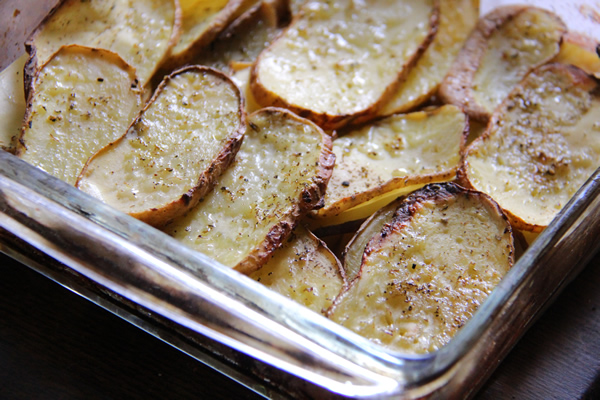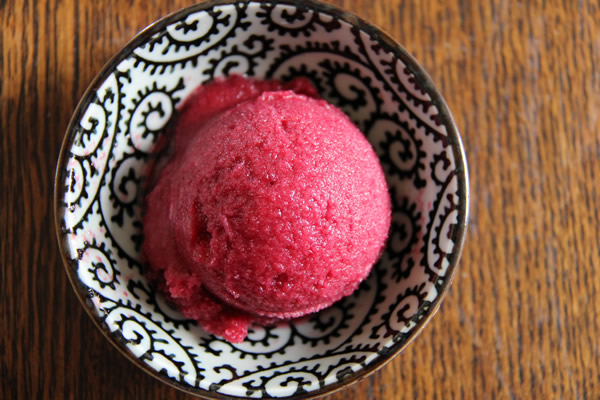You’re low on flour, rice is scarce, and your pasta stash is down to one lonely box of elbows. Thank Heaven for potatoes. Especially when it’s easy to dress them up Greek-style—bright, pungent and with an aroma so intoxicating it could serve as stress-relief therapy.
“Greek-style” is simply shorthand for “lemon, oregano and olive oil” (the way “Florentine” means spinach). But this is not your standard dish of crispy potato wedges done up Greek-style. Here, layers of thinly sliced potatoes roast and steam, soaking up caramelized lemon sauce and blissing out on oregano. Cut into the casserole and you’ll find strata of textures and flavors, from soft and creamy on the bottom to crispy on top. Imagine Mediterranean, dairy-free scalloped potatoes.
This is yet another treasured recipe from Elinor Lipman. It dates back to our two years’ rooming together after college, before she took up writing best-selling fiction and before I set up Brody Marketing’s world headquarters in my bedroom.
“The recipe was from some international cookbook, a paperback I no longer have,” she says, so the provenance remains a mystery. It is still a favorite for both of us. Confident of its ease and lusciousness, I entered it into a cooking contest—with Elinor’s permission, of course. I christened it “Patates Elinora” in homage. It didn’t win, but the name stuck.
Use whatever potatoes you have on hand—russets, Yukon Golds, and I suppose even purples. Just watch out—this might upstage the rest of your meal.
Patates Elinora (Greek-Style Potatoes)
- A mandoline or 2mm slicing disc on a food processor speeds prep. (Elinor cautions, “Watch yer fingers with that mandoline!”)
- Choose a casserole dish narrow and deep enough to allow for several layers and that special steaming effect. For instance, using a casserole 6 1/2″ x 8″ x 2 1/2″ high, I got about seven thin layers.
- You can jump-start the recipe to save time by cooking, covered, in the microwave until potatoes slightly soften. Then uncover and roast in the oven to brown.
1. Preheat oven to 375 degrees.
2. Wash and pat dry 4 large potatoes (or equivalent smaller ones). Slice thinly length-wise (no need to peel). Oil or butter a casserole dish. Put one layer of potato slices on bottom. Sprinkle with salt, pepper and oregano.
3. Repeat layering and seasoning until one more layer of potatoes remains.
4. Top casserole with last layer of potato slices. Pour 3 tablespoons lemon juice over top, then 3 tablespoons olive oil. Sprinkle with salt, pepper and oregano.
5. Bake, covered, in 375-degree oven until potatoes are tender, about an hour. Insert fork to check for doneness during cooking.
6. Uncover casserole to crisp the top layer, for about 15 minutes or until it reaches desired golden color.






3 Comments
Leah Greenwald
Wow, you’ve got a great steady hand if those are hand-sliced. I think the recipe is perfectly clear. I haven’t tried it yet, but it looks like a very appealing vegan cousin of Pommes de Terre Anna.
As for my eye: drafting to scale for 45 years trains the eye.
Diane Brody
Hey Leah,
Wow, you’ve got a great eye! I cut the potatoes in the top photo by hand, so they are a little thicker than with a slicing disc. Elinor recommends the 2mm slicing disc, so please use that. The potatoes in the top photo are Yukon Golds I believe.
I made the potatoes again using a mandoline to slice them, and they came out very thin and baked up really well. I added a photo of these next to the recipe to show the layers. These are russets, which are indeed longer, and are quite delicious in this dish.
I hope this helps, and please let me know if you think I need to explain more. It’s an easy dish, and appreciate your letting me know where it needs clarification!
Thanks so much!
Diane
Leah Greenwald
How thick would you say the slices are? I have a 2mm slicing disc and a 4mm. The photo looks they’re about 1/8″, which is about 3mm. Also, the pan you used is almost square, which means the potatoes you used were about 3-1/2″(+) inches, but most russets I see are 5-1/2″ to 6″ (I also just interviewed four of them in my fridge). What variety is in the photos?